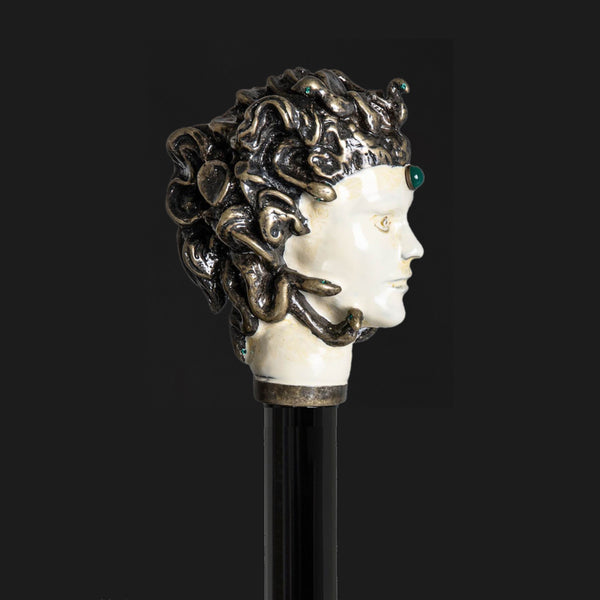You have no items in your shopping cart.
Recent Posts
-
Why an Elegant Cane Is a Thoughtful Gift for Loved Ones?
-
The Art of Christmas Design: Walking Canes That Celebrate the Season in Style
-
How an Ergonomic Walking Cane Handle Prevents Hand and Wrist Strain?
-
How to Walk With a Cane Correctly to Avoid Back or Shoulder Strain?
-
5 Common Mistakes People Make When Buying a Walking Cane (and How to Avoid Them)
-
How to Choose a Walking Cane That Reflects Your Personality (Not Just Your Needs)?
MOST POPULAR NOW
09
Jan
Beyond their utilitarian purpose, walking canes have transcended into the realm of art, becoming sculptural masterpieces that blend functionality with aesthetic expression. In this exploration, we take a leisurely stroll through the world of walking canes, uncovering the craftsmanship, history, and artistic ingenuity that transforms these humble accessories into captivating works of art.

A walk through art: walking canes as sculptural masterpieces
The intersection of art and functionality
Walking canes have a rich history dating back centuries. Initially employed for support and stability, they have evolved into symbols of style, status, and self-expression. Today, artisans craft walking canes that seamlessly marry form and function, turning a practical item into a personal statement.
Materials of elegance
Wood remains a favored medium for crafting walking canes. Artisans meticulously carve, shape, and finish wood to create unique designs. Exotic woods such as ebony, rosewood, and mahogany add a touch of elegance, while intricate inlays and hand-carved details transform the cane into a wearable masterpiece.
Metal walking canes showcase a different form of artistry. Crafted from materials like brass, silver, or aluminum, these canes often feature intricate designs, filigree work, or sculpted handles. The combination of metals with other materials like leather or wood results in visually stunning and durable creations.
Sculptural handles: a symphony of forms
The handles of walking canes serve as the focal point, where artists unleash their creativity. From animal-inspired designs to abstract sculptures, these handles elevate the cane to a form of personal expression. The ergonomic consideration in handle design not only enhances grip but also adds to the overall visual appeal.
Historical and cultural influences
The Art Nouveau movement has left an indelible mark on walking cane design. Characterized by flowing lines, intricate patterns, and nature-inspired motifs, Art Nouveau canes capture the essence of this artistic era.
Walking canes often reflect cultural influences. From tribal patterns to symbols of status, these canes offer a glimpse into the diverse narratives that shape artistic expression around the world.
In recent years, walking canes have found their way from exclusive galleries to the bustling streets. Contemporary artists and designers collaborate to create limited-edition canes that bridge the gap between traditional craftsmanship and modern aesthetics. These wearable artworks cater to a new generation seeking both function and individuality.
Collecting and preserving artful canes
For enthusiasts, collecting walking canes becomes a passion. Each piece tells a unique story, whether it's a vintage masterpiece from a bygone era or a modern creation by a renowned artist. Curating a collection allows individuals to showcase their appreciation for the artistry of walking canes.
To maintain the integrity of these sculptural masterpieces, proper care is essential. Storing canes away from direct sunlight, regular cleaning, and avoiding excessive moisture contribute to their longevity. Preservation ensures that these works of art can be enjoyed for generations to come.
Conclusion
Walking canes, once mere tools for support, have evolved into sculptural masterpieces that transcend time and function. The intersection of craftsmanship, materials, and artistic expression has elevated these accessories to the status of wearable art. As we continue our walk through the world of walking canes, let's appreciate the fusion of art and functionality that turns each step into a unique artistic journey.
Also Purchased
-
Beige Walking Cane for Ladies Chamomile Flower, Wooden Walking Stick
Introducing our beautiful Beige Walking Cane for Ladies with Chamomile Flower, a Wooden Walking Stick that is hand carved and handmade, making it both pretty and unique. This walking cane...$99.00$87.45 -
Black Skull Head Walking Stick, Wedding Ceremony Designer Skull
Looking for a stylish and unique walking stick to elevate your look at your next event? Check out our Black Skull Head Walking Stick, the perfect accessory for any wedding...From $238.70 -
Exotic Burl Wood Walking Cane – Fashionable Artisan Stick
A sculptural statement in deep, oceanic blue — this walking cane is more than a support accessory, it's wearable art. Meticulously hand-shaped from stabilized burl wood, the handle evokes the...$467.50 -
ArtWalkingSticks™ MAGIC Walking Cane, Handmade - Make to Order
This piece of art is created for those who value details. We make one of a kind, handcrafted wood and resin canes. Our Wooden Canes are completely unmatched in creativity....$473.00 -
Umbrella with Eagle Handle, Fashion Umbrella For Men
Make a bold and fashionable statement with our Umbrella with Eagle Handle - a unique and functional accessory designed for men. The striking eagle handle is the highlight of this...$357.50 -
Fashionable Lion Shoehorn Long Handle, Pearly Brown Shaft, Handmade
Introducing our Fashionable Lion Shoehorn, a handcrafted, long-handled shoe horn with a pearly brown shaft that's both stylish and practical. The intricate Lion design adds a touch of elegance to...$264.00
































